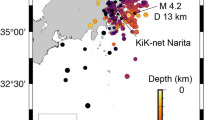Abstract
In two-component seismic observations with vertical and in-line horizontal geophones, the compressional (P-) wave amplitudes, as well as the vertically polarized shear (SV-) wave amplitudes, are observed on both vertical and horizontal geophones. In our case, we use a P-wave source, while the SV waves are the result of mode conversion. The mode-conversion mechanism considered here is related to the near-surface layers, i.e. we have a P-leg from the source and mode conversion at/in the weathered layer. The resulting SV waves therefore will show lateral variations because the elastic parameters of the near-surface layers vary along the seismic line, but these variations will be consistent at the surface. This effect is demonstrated by a synthetic example based on elastic parameters representative of the actual seismic line being considered. To separate the individual P and SV arrivals, we apply a two-dimensional convolution filter designed to meet the wavenumber-frequency (k-f) domain transfer function for P-SV separation which can be derived from thek-f domain geophone-receiving characteristic and the near surface P- and S-wave velocities. The reason for P-SV separation filtering in the offset-traveltime (X-T) domain instead of directly filtering in thek-f domain, is a great saving in computer time, asX-T filters, with few coefficients, can be used. In this paper, after a short summary of thek-f domain P-SV separation filters and their transformation to theX-T domain, we apply theX-T filters to synthetic data in order to demonstrate that our design is correct. We also work on actual data and discuss the problems being faced, which mainly, originate from the different geophone groups and, as a consequence, the different scalings of vertical and horizontal geophones. The main advantage of two-component seismic observations is two-fold: firstly, a clean P-wave section is obtained (SV-energy arriving at the receivers is cancelled by applying the foresaid separation filter) and, secondly we obtain an additional SV-wave section at almost no cost to data acquisition. These two sections contribute towards distinguishing between true and false bright spots, so they are, used as direct hydrocarbon indicator tools.
Similar content being viewed by others
References
Anno, P.: 1983, ‘Statics Solutions and Event Correlations: Two Critical Aspects of Shearware Exploration’, 53rd SEG convention, Las Vegas, U.S.A., Expanded Abstracts, S. 8.2.
Brötz, R., Marschall, R., Götze, K., Mosler, M., Rosilius, R., and Bergert, K.: 1987, ‘Report on Data Processing of the Test Survey “Settala 1985”’, Report, Prakla-Seismos AG, Hanover.
Dake, L.P. 1978,Fundamentals of Reservoir Engineering, Elsevier, Amsterdam.
Danbom, S.H. and Domenico, S.N.: 1986,Shear-Wave Exploration, Geophysics Development Series, Vol. 1, Society of Exploration Geophysicists, Tulsa, Oklahoma.
Dankbaar, I.W.M.: 1982, Comment on ‘SHOVER’,Geophys. Prospecting 30, 519–520.
Dankbaar, I.W.M.: 1985, ‘Separation of P- and S-Waves’,Geophys. Prospecting 33, 970–986.
Deluchi, L., Marschall, R., and Werner, H.: 1989, ‘Retrocorrelation Noise Related to Dual Source Vibroseis Technique’, submitted toGeophys.
Edelmann, H.A.K.: 1981, ‘SHOVER Shear-Wave Generation by Vibroseis Orthogonal to the Polarization’,Geophys. Prospecting 29, 541–549.
Ensley, R.A.: 1985, ‘Evaluation, of Direct Hydrocarbon Indicators Through Comparison of Compressional Wave and Shear Wave Seismic Data: A Case Study of the Myrnam Gas Field, Alberta,Geophys. 50, 37–48.
Errico, G., Savelli, S., and Flores, P.: 1981, ‘25 Years of Stratigraphic Traps Exploration in the Po-Valley/Italy, Direzione Esplorazione Idrocarburi, San Donato Milanese (MI). Preprint AGIP, Milan.
Fertig, J.: 1986, ‘Scherwellen in der angewandten Seismik’, II. Mintrop-Seminar, Kassel.
Fertig, J.: 1987, ‘Data Acquisition and Processing of Converted pS-Waves’,Geophys. Prospecting,35, 148–166.
Fertig, J. and Krajewski, P.: 1989, ‘Acquisition and Processing of Pure and Converted Shear Waves Generated by Compressional, Wave Sources’,Surveys in Geophys. 10, 103–132 (this issue).
Gregory, A.R.: 1976, ‘Fluid Saturation Effects on Dynamic Elastic Properties of Sedimentary Rocks’,Geophys. 41, 895–921.
Gutenberg, B.: 1932, ‘Erdbeben: Handbuch der Geophysik’, Band IV, Borntraeger, Berlin.
Han, D., Nur, A., and Morgan, D.: 1986, ‘Effects of Porosity and Clay Content on Wave Velocities in Sandstones’,Geophys. 51, 2093–2107.
Kind, R.: 1976, Computation of Reflection Coefficients for Layered Media,J. Geophys. 42, 191–200.
Knopoff, L., Fredericks, R. W., Gangi, A. F., and Porter, L. D.: 1981, ‘Surface Amplitudes of Reflected Body Waves’,Geophys. 22, 842–847.
Lang, S.W. and Oristaglio, M.L.: 1988, P-Wave and S-Wave Separation in Thin Beds,IEEE Trans. Geosci. Remote Sensing 26, 177–186.
Marschall, R.: 1983, ‘Wavelet Processing and Pseudologs’, 3. Mintrop-Seminar.
Marschall, R.: 1986, ‘Processing of Shearwave-Data’, 8th EGPC Conference, Cairo. Preprint Prakla-Seismos AG, Hanover.
Marschall, R. and Knecht, M.: 1986, ‘Simultaneous Processing of P- and S-Wave Data’, 48th EAEG Convention, Ostende, Belgium. Preprint, Prakla-Seismos AG, Hanover.
Mazzotti, A.: 1984, ‘Prestack Analysis of Seismic Amplitude Anomalies’, 54th SEG Convention, Preprint, AGIP, Milan.
Murayama, R., Uchida, M., and Umendo, A.: 1987, Observation of P- and S-Waves Generated by P-Wave Vibrators by Three Axis Borehole Geophone’,Butsari-Tansa 40, 176–187.
Neidell, N.S.: 1985, ‘Land Applications of Shearwaves’,Leading Edge 4, 32–44.
Pieri, M. and Groppi, G.: 1981, ‘Subsurface Geological Structure of the Po Plain, Italy’, Pubblicazione No. 414, Progretto Finalizzata Geodinamica.
Pieri, M. and Mattavelli, X.: 1986, ‘Geological Framework of Italian, Petroleum Resources’,AAPG Bull. 70, 103–130.
Robertson, J.D.: 1987, ‘Carbonate Porosity from S/P Traveltime Ratios’,Geophys. 52, 1346–1354.
Tatham, R.H.: 1982, ‘V p /V s and Lithology’,Geophys. 47, 334–344.
Waters, K.H.: 1978,Reflection Seismology, Wiley, New York.
Author information
Authors and Affiliations
Rights and permissions
About this article
Cite this article
Mazzotti, A., Ferber, R.G. & Marschall, R. Two-component recording with a p-wave source to improve seismic resolution. Surv Geophys 10, 155–223 (1989). https://doi.org/10.1007/BF01901491
Accepted:
Issue Date:
DOI: https://doi.org/10.1007/BF01901491




